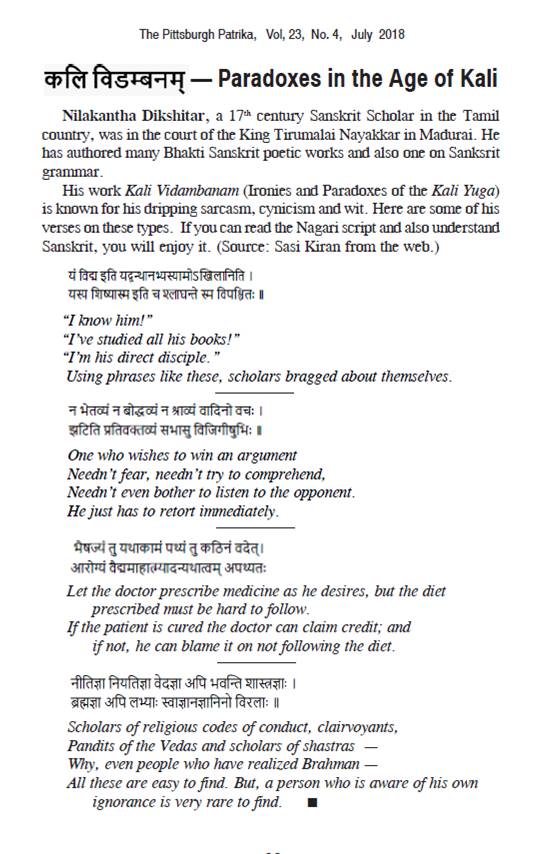Why Is Coronary Heart Disease Such A Big Problem Among Indians?
Posted by admin in October 2018, Past issues on November 18, 2018
By Dr Padma Garvey, MD Hudson Valley, NY
e-mail:Â pgarveymd@gmail.com
Editor: Padma was born in Nellore India and grew up in Pittsburgh. She earned her medical degree from the 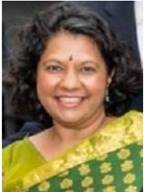 University of Pittsburgh in 1992. She is a full-time gynecologist in the Hudson Valley area, married to her physician-husband for 25 years. She has two kids in college. She practices yoga and is dedicated to teaching people about the benefits of a plant-based diet. She has a website (www.drpadmagarvey.com).
University of Pittsburgh in 1992. She is a full-time gynecologist in the Hudson Valley area, married to her physician-husband for 25 years. She has two kids in college. She practices yoga and is dedicated to teaching people about the benefits of a plant-based diet. She has a website (www.drpadmagarvey.com).
Asian Indians have some of the highest rates of coronary artery disease and diabetes in the world. I know from personal experience that many Indians are lulled into a false sense of security because they tend to be vegetarians. My own father, the late Dr. K N Rao, had diabetes. Eventually, he needed bypass surgery, but this extended his life by only two years. In addition, those two extra years of life were spent confined to a bed. Though my father had always been a strict vegetarian, he ate a high fat diet. Dinners included chutneys, ghee on lentils, fried papadam, fried pooris, tamarind rice with lots of oil and white rice, fried samosas, sugary laddoos, sugary jilebis, and yogurt. In addition, the typical Western snacks crept into his life. He ate potato chips, ice cream, candy, and cakes.
There is lot of misinformation about what a healthy diet includes. We hear fat is bad, fat is good. We hear that carbs are the enemy. We hear that protein-centered diets like the keto diet or paleo diet are bad for us.
In actuality, the evidence regarding a healthy diet has been known since the 1930s when Dr. Ancel Keys conducted the famous Seven Country Study. Keys found that countries that consumed low fat diets had better health than countries that consumed high fat diets. In particular, Keys found that the Okinawan and Mediterranean diets in 1930 were extremely healthy having 10-18% total fat.
I came across an interesting study published in the prestigious medical journal The Lancet in 1959, entitled “Serum Cholesterol, Diet, And Coronary Heart Disease in Africans and Asians in Uganda†by Shaper et al. At the time of the publication of this study, coronary heart disease (CAD) was nonexistent among African Ugandans. This alone is a shocking statement since CAD is the Number One killer of African Americans today. While CAD was nonexistent in the African community, it accounted for 43% of all deaths over the age of 30 among Asian Indians in Uganda at that time.
The authors examined the diets of the two communities. The African Ugandans ate a diet which included green leafy vegetables, maize, millet, yams, and beans. They ate very little meat and absolutely no dairy. They did not utilize much cooking oil in their cooking and consumed whole grains. In contrast, the Asian Indians in Uganda in 1959 were consuming white rice, lentils, butter/ghee, yogurt, milk, and lots of cooking oil. The total fat calories in the African Ugandan diet was about 18%. The fat calories in the Asian Indian diet in Uganda was 35-40%.
The typical middle-class, vegetarian Indian diet is even worse today. In general, vegetarian Indians are consuming more refined grains, added sugars, oils, animal dairy, and even cheese. A low-fat, whole grain, plant-based diet has been the only diet ever shown to reverse heart disease. This study conducted by Dr. Dean Ornish was published in the Lancet in 1990. When it first appeared in The Lancet, the results were so startling that many in the medical community felt that it would revolutionize the way CAD was approached and treated. Dr. Dean Ornish even made it on the cover of Time Magazine with the subtitle asking if this was the end of heart disease.
Unfortunately, the fact that Ornish published his ground-breaking research in the British journal, The Lancet, suggests that the American journals passed on it. Around the 1960s, most American medical journals, American medical societies, and even American medical school education were supported by the pharmaceutical industry.
President Bill Clinton suffered a heart attack shortly after he left office. He had bypass surgery. After his surgery, he was on the standard regimen of medications including cholesterol-lowering drugs and told to follow the American Heart Association (AHA) diet. Interestingly, though the Ornish diet was the only diet ever shown to reverse plaques, the AHA recommends the less effective DASH diet. Clinton was quite frightened after his heart attack and followed his cardiologist’s recommendations.
About 18 months later, President Clinton had a re-occlusion or buildup of plaque in his heart. He underwent angioplasty. I remember watching reporters questioning Clinton’s cardiologist at the time. The reporters wanted to know why Clinton had a recurrence of his heart disease despite following the AHA guidelines. The cardiologist said, there was nothing more that could be done about it and that Clinton had bad genes.
Clinton was not satisfied with this response and talks openly about seeking other treatment options. Clinton came across the Ornish study and went to Dean Ornish for guidance. Clinton became a strict low-fat vegan. His daughter, Chelsea, is also one. Since following the Ornish diet, Clinton has been heart disease-free. The past president of the American College of Cardiologists, Dr. Kim Williams from Rush Medical Center says that there are only two kinds of cardiologists, vegans and ones who are unaware of the data.
Indian physicians must be made aware of the proven benefits of a low-fat, whole grain, plant-based diet. We need to educate the Indian community as well as all our patients to avoid needlessly painful, early, and costly deaths. Excellent resources for more information are on the Physicians Committee for Responsible Medicine (PCRM) website.
♠
Home:
Time to Reform Cremation/Death Rites for Hindus in the US
Posted by admin in October 2018, Past issues on November 18, 2018
By Kollengode S Venkataraman
e-mail:Â ThePatrika@aol.com
Editor’s Note: A slightly modified version of this article appeared in the April Issue of Hinduism Today.
Death rituals — burials and cremations or other practices — are perhaps more for the living left behind to come to terms with grief and get a cathartic relief at the irrevocability of the Final Exit. For people who pass on in their 80s and 90s, the death rites are also occasions for great celebrations for reminiscing the lives of the departed. After all, the departed would have seen so much of life’s ups and downs, very personal griefs, frustrations, disappointments, excitements, successes, failures, and touched the lives of many people in very many ways.
A large proportion of Hindus use cremation for taking care of the dead. A relatively small fraction of Hindus also use burials. Traditionally, if people die in the forenoon or early afternoon, the cremation was expected to be done before sun down. For Jews and Muslims too, traditionally, the burials must be done before sun set, not always possible today.
For the Hindus today in many places outside India, cremation or burial on the same day of the death is simply not feasible because of medicolegal requirements of hospitals, autopsy, death certificates, funeral homes’ requirements, etc. Typically, it takes two to three days to organize cremation in North America after the Final Exit. If long weekends intervene, cremation takes place only after four or five days after the death. This is the reality today.
Further complication with Hindu cremation is that we need a pandit or a purohit to do the death-related rites for several days after cremation. In olden days when our ancestors lived in villages, on the day after cremation, the ashes were gathered and were sprinkled into the river or ocean, or lakes. Afterwards, there were daily rites for the departed for the next several days, at the end of which the departed Jiva was ritually merged with the departed ancestors. All these are called Antyeshthi karmas (NOT pujas).
Then, on the 13th day in many cases, there is a formal puja invoking the blessings of Nature for people to come to terms with the death of the departed so that people can get on with their lives. This puja goes with various names in different parts of India. In cases where people in the prime of their lives suddenly die in accidents or under complicated medical conditions, getting on with their lives is not easy. It takes years to come to terms with cruel games Life/Fate/Bad Luck plays with people.
A great many variations are there in the details of the rites from region to region and even within the region in different families with customs evolving over several centuries, compounded by geographic isolation.
Even fifty years ago, for people who die after a long life, siblings and cousins, nephews and nieces, and grand-kids and also close friends assembled for the 13th day Pujas to joyfully reminisce the life of the departed. There is a great fellowship and camaraderie in these celebrations.
The 13-day death rites and celebrations, which was OK during our countryside leisurely life, are simply not sustainable in today even in India, not to speak of Hindus living outside. There are several practical reasons: For starters, today, the members of the family are scattered globally. Further, people have only two weeks of paid vacations, and they have very busy work routines. Children need to go to schools and colleges. And people running shops or small businesses cannot afford to be away from their shops for long duration.
Today, relatives — sometimes even siblings — rarely participate in all the key events such as the cremation itself, immersion of the ashes, and the 10th and 13th day events. It simply is not possible in contemporary lifestyle.
The saddest part of the system as it exists today is that often the husband and wife, often in their 60s or even older, do the 9th and 10th day karmas (rites), and the 13th day puja all by themselves, or with very few people to give them emotional support.
A great opportunity is thus lost for the extended family members and friends to commiserate among themselves during such a somber and evocative occasion. We need to remember that after the death of aged parents, the siblings slowly and naturally drift away from each other in the normal course of the flow of Time.
So, the 13-day death rites even for observant Hindus, for all intents and purposes, are already modified to varying degrees to to accommodate the present day constraints and lifestyles.
Need for Reform on Death Rites
Given our changed lifestyle today, it is time that we are honest to discuss in the open the need for reform on death rites. We need to come up with a set of shortened and reformed death rites that will be an alternative optional standard for all Hindus who cremate/bury the mortal remains of the departed Jiva.
In stating this, I am NOT suggesting any radical change. Those who want to do in the traditional 13-day event may continue to do it that way. However, for others who have other constraints as listed earlier, we can come up with death rites that can be done, say, within three days after the cremation, while still retaining the key elements of the 13-day events. Thus, the whole sequence will be completed within three (or four, or five) days after the cremation, which is a more manageable time-wise for all extended family members to participate.
A shortened death rites will greatly help all relatives to gather for all the death rites and observances and celebrate the life of the departed.
It is not fair to place the onus for shortening the rites on the individual Pandits/Purohits. They are already caught between a rock (their traditional training in pathashalas) and a hard place (their clients asking for all kinds of compromises). They have their own ethical codes that they do not want to drift too far away from unless they get social approval for the shortened version of death rites. We need to ask for it.
That is why we, the Hindu faithfuls, need to make an acceptable compromise on the core steps involved in death rites. Again, those who want to follow the 13-day practice, can continue to do so. We need to meld these rites into our contemporary lifestyle and fit them into 3 or 4 days after the day of cremation. Are we ready for discussing this in the open?
Remember, the 3- or 4-day marriage events of the olden years has been seamlessly shortened to 1-day or even 1/2 day event today to fit our convenience.
Also, I heard in one lecture that even Manu in his smrti, has wisely stated that the codes he has given us need to be revised to adapt to the evolving lifestyles, much like constitutional amendments and changes in the laws we see today. ♠
Home:
Mental Illness, A Worldwide Epidemic: A Hindu Millennial’s Call to Action
Posted by admin in October 2018, Past issues on November 18, 2018
Raashmi Krishnasamy Â
e-mail:Â raashmik@andrew.cmu.edu
Editor: Raashmi Krishnasamy, currently a senior in Cognitive Neuroscience major at Carnegie Mellon University, is 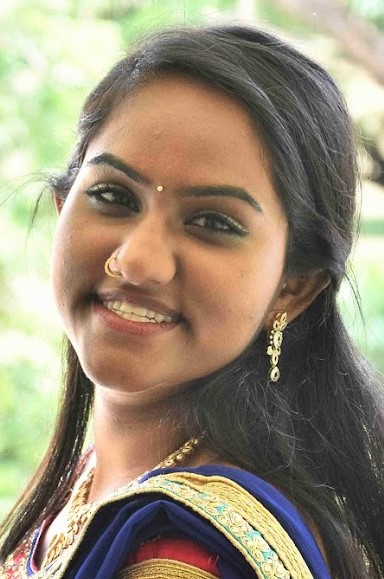 a passionate advocate for mental health, particularly within the South Asian community. She aspires to combine her knowledge of neuroscience with public health to provide more equitable access to healthcare for individuals with mental health problems. She is dedicated to preserving her Indian cultural roots through activities on and off campus. Currently, she is the Co-Director for Bhangra in the Burgh 12, a nonprofit Bhangra competition hosted by Carnegie Mellon and Pitt students to raise money for the Creative and Expressive Arts Therapy program at the Children’s Hospital of Pittsburgh.
a passionate advocate for mental health, particularly within the South Asian community. She aspires to combine her knowledge of neuroscience with public health to provide more equitable access to healthcare for individuals with mental health problems. She is dedicated to preserving her Indian cultural roots through activities on and off campus. Currently, she is the Co-Director for Bhangra in the Burgh 12, a nonprofit Bhangra competition hosted by Carnegie Mellon and Pitt students to raise money for the Creative and Expressive Arts Therapy program at the Children’s Hospital of Pittsburgh.
The World Health Organization’s recent report says that by 2020, depression will be the 2nd leading cause of disease; by 2030, it is set to outpace heart disease as the #1 cause of disease worldwide. An estimated 97.5 million people are suffering from mental illnesses in India alone. The incidence of depression is about one in every twenty Indians — roughly 5% of the country’s population. And it’s only getting worse. Chidren of our Bharat Maata is suffering from a serious mental health crisis.
Why is the birthplace of yoga, meditation, and mindfulness also home to about half of the global mental illness disease burden? And why hasn’t it shown signs of stopping?
The answer is simple – our attitude. We fear sharing our feelings with others. We judge and fear judgement towards individuals with mental illness. But most importantly, we fear ourselves, and fear admitting that we may actually need some help, after all. All of this fear contributes to strengthening the stigma, forcing us further and farther away from what we really need—direct confrontation. However, we’re a long way from tackling this issue face-to-face.
According to the Live Love Laugh Foundation, in a survey of 3,556 respondents from eight cities across IAndia, 47% could be categorized as being highly judgmental of people perceived as having a mental illness. Of the 47%, respondents were more likely to say that one should keep a safe distance from those who are depressed, or that interacting with a mentally ill person could affect the mental health of others. And the worst part – 26% were categorized as being afraid of the mentally ill.
But are we afraid of people with diabetes? Or hypertension? Why should we view mental illness any differently?
Like any other chronic illness, mental illnesses have both a behavioral and a physiological component. The only difference here is that instead of focusing on the heart or pancreas as in the case of heart problems and diabetes, the area of interest in mental illness is the brain.
In the mental health issues among Indians, when does it all stop? When does the fear stop and the courage begin? When do we stop being afraid and start being brave enough to confront our inner demons? How do we stop taking step backwards and start to move forward in our fight against this disease?
I offer somewhat of a trivial solution: let’s change the way we view mental illness and begin to treat it as a worldwide epidemic. The formal definition of an epidemic is the widespread occurrence of an infectious disease in a community at a given time. That is precisely what mental illness is – it’s a widespread, infectious disease, plaguing not just one community, but hundreds of thousands across the globe, right now!
The WHO suggests that reversing epidemics, is a 3 step process:
- Interrupt transmission
- Prevent future spread
- Change group norms
Thankfully, when it comes to mental health, we don’t have to do all these 3 things – we only have to do one; we must change group norms. But just how do we go about changing group norms?
They say that the hardest thing to do when it comes to treating a mental illness is acceptance – by the individual. But it’s bigger than that; it has to do with group [or socia]) acceptance acceptance.
In the Bhagavad Gita, Krishna declares, “The man who sees me in everything and everything in me will not be lost to me, nor will I ever be lost to him. When he sees all beings as equal in suffering or in joy because they are like himself, that man has grown perfect in yoga.â€
We must look not only look beyond ourselves, but also within ourselves. Group norms aren’t something that just change overnight. They begin with the individual. Changing the way we view ourselves will allow us to see what Krishna preaches in the Gita — we will begin to see others as being equal in suffering.
So next time you’re feeling a little down, or you hear about or see someone struggling with symptoms of mental illness, take a minute and set all the judgements aside. Rather than being afraid of yourself or that person, be brave enough to give your love and compassion. Rather than offering pity, offer support. Rather than shying away from the conversation, become an advocate. Together, we can change group norms and beat the worldwide epidemic that’s shamelessly claiming the minds of many. All we have to do is speak up and inspire others to do the same.   ♠
Home:
Dr. Swami Nathan Receives Life-Time Achievement Award in Psychiatry
Posted by admin in October 2018, Past issues on November 18, 2018
(Paul) G. Manoharan, Upper St Claire, PA
e-mail:Â gopalsamy.manoharan@stifel.com
On September 24, 2018, the Pittsburgh Psychiatric Society presented the “Lifetime Achievement Award for Academic Psychiatry†to Dr. Swami Nathan, MD, DLFAPA, to honor “outstanding contributions and devotion to academic psychiatry and to the Pittsburgh Psychiatric Organization.â€Â  All of his friends in the
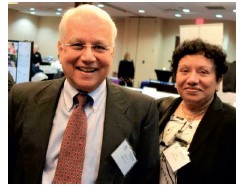
Dr. Swami Nathan and his wife Girija
Pittsburgh area who have known Dr. Nathan’s accomplishments for many years were gratified to see this richly deserved honor bestowed on him by his professional peers. True to his characteristic humility, Dr. Nathan credits his several mentors he was fortunate to have had in his life.
For the Pittsburgh Indian community for a long time, Dr. Nathan has been the “Go To†psychiatrist during times of distress and misfortune. He was always there to guide through difficult transitions with his expertise and appreciation of the difficulties with our unique cultural differences. For several years, Dr. Nathan worked with children in the Temple youth camps and was very popular with children for his understanding of their concerns.
Dr. Nathan came to the US in 1973, armed with a medical degree from the Stanley Medical College of the University of Madras and accompanied by his new bride, Dr. Girija, his heart throb in college, to start his residency in psychiatry in New York, followed by his fellowship at New York State Psychiatric Institute and Columbia University. He was an Assistant Professor of Clinical Psychiatry at Columbia until 1980.
Dr. Nathan came to Pittsburgh in 1980 to be an Assistant Professor of Psychiatry at the University School of Medicine and Western Psychiatric Institute and Clinic and served as a Medical Director at Western Psych. He then moved to Allegheny General Hospital to become Vice Chairman, Department of Psychiatry and Professor of Psychiatry at the Medical College of Pennsylvania and Hahnemann University. Currently, Dr. Nathan is retired and enjoying a life of leisure with his wife Girija and nurturing their two lovely grandchildren.
For his many friends in Pittsburgh, Dr. Nathan is a warm friend with a helping hand, a good sense of humor and an ever-present positive outlook. May God Bless the Nathans.  ♠
Home:
The Fall Midterm Elections Are Important
Posted by admin in October 2018, Past issues on November 18, 2018
By Kollengode S Venkataraman
In every election, as a matter of routine, we need to show our faces at the polls to tell everyone that we take our civic duties seriously. Besides, being a relatively new group of immigrants into this these great United States, showing our faces at the polls is one sure way to slowly get acceptance into the American mainstream.
In addition to the above Boiler Plate need for us to go to the polls, the coming midterm polls this November is important for one additional reason as well.
The Pennsylvania state supreme court has redrawn the maps of the Congressional districts in Pennsylvania this year to reflect the voting patterns for offices elected by state-wide voters such as the offices for the governor, US senators, and attorney and auditor generals. We discussed this in a lengthy article two issues ago. See here for the article. In the past, the GOP-controlled Pennsylvania state legislative bodies in Harrisburg, using its majority in the state legislature and with help from the GOP governors, managed to gerrymander the Congressional district maps and gave undue advantage in sending a large contingent Republican member to the US House of Representatives in Washington, DC. Thus, in a moderately center-right state that is Pennsylvania, Republicans garnered 13-5 advantage by the blatantly skewing the congressional district maps in their favor. The redrawing of these maps is mandated to be adjusted based on population changes revealed in the decennial census.
With the redrawn maps for the congressional districts, now GOP has only a 10-8 advantage in the congressional delegation. The delegates elected in the upcoming November election is more likely to be representative of the broad electorate of the state.
So, this is one very good reason why you should go to the polls in November. Now you have a good chance to change the GOP’s skewed majority in the US House of Representatives. And may be also in the US Senate as well. So, please go to the polls this November.  ♠
Home
Kali Vidambanam — Paradoxes in the Age of Kali
Posted by admin in July 2018, Past issues on July 23, 2018
Good Bye to Swim Suit in Beauty Pageants
Posted by admin in July 2018, Past issues on July 22, 2018
Premlata Venkataraman
ThePatrika@aol.com
The Miss America contest has scrapped its swimsuit competition, striking at the most derided part of the contest. It is long overdue. Coming in the wake of the #MeToo movement that exposed sexual harassment — actually, sexual abuse — of women in many walks of life, this is a blow to the outdated, voyeuristic and prurient aspects of beauty contests.
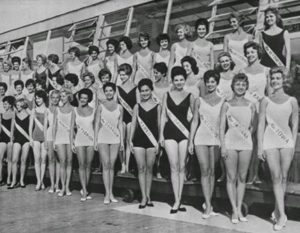
The Swim-Suit picture of Miss America 1962, staid by today’s standards.
In recent years, viewership interest — and corporate sponsorship — in beauty pageants have been dwindling in industrialized societies in the backdrop of changing social mores and attitudes between men and women and in the way society judges women. At least in public discourse, men and women in the First World rejected the idea of subjecting women to this kind of objectified evaluation in terms of the size of their bust, waist and buttocks and how well they filled a bikini. The Feminist Movement and women with professional degrees joining the work force in large numbers in the last several decades have contributed to this transformation.
Sadly, however, this contest is gaining feverish attention from emerging countries like India and China, and in Latin America, and parts of less developed parts of Europe. To capture a greater share in high-end middle class markets

By 2015, only bare essentials are covered with not much left to cover Swim Suit parade.
in cosmetics and designer apparel, global companies now sponsor these events in Asia. Never mind that it goes against the prevailing culture of modest attire in these countries.
With the Second and the Third World aping their Western counterparts in everything (see the swim suit photoshoot on the next page in the 2017 Miss India contest), here too, I am sure, they will ape the West by scrapping the bikini contest, going forward.
That is why it is important that Women’s Movements retain the cultural values of their lands, even as they work towards bringing fundamental changes to reduce gender-based violence and domestic abuse.

Indians are catching up with the West… … in this too. Miss Miss India Suit 2017.
There is a visual image associated with social workers in India. They are called jholiwalas and Jholiwalis, because they always wear simple khadi clothes with a cloth bag slung over their shoulders. To convey their important message they always wear simple cotton dresses in local designs.
I am glad Miss America 2.0 did away with the swimsuit (bikini) category. It is time women are judged not only for their attractive looks in attractive everyday clothes, but also for their wit and intelligence.   ♣
Home
Indian Poets: Cynical, Sarcastic, Humorous All at the Same Time
Posted by admin in July 2018, Past issues on July 22, 2018
By Kollengode S Venkataraman
ThePatrika@aol.com
Many short verses in Indian languages deal with honor, dharma, compassion, beauty, obligations and responsibilities, romance, love, devotion and bhakti — in high-brow and uplifting tones. But many are also known for their dripping sarcasm, cynicism, and hard realities of life.
Here are two 4-line alliterating and rhyming Tamil verses in the latter category. Nothing is known about the authors of these verses. (Source: Viveka Chintamani, editor Gna. Manikkavasagam, Uma Pathippagam, Chennai, 600 001, Year 2001). However, on the basis of the words and phrases in them, one can say that these verses cannot be earlier than 1700 AD. With Tamil having at least 2500 years of literary history, these verses are, therefore, relatively recent, only 300 years old. Here is the original of the first Tamil verse:

Here is a nonliterary translation:
Once they become adults, sons won’t listen to their fathers’ advice;
After middle age, wives wearing fragrant flowers won’tÂ
       care for their husbands;
After learning from teachers, shishyas (students) don’t goÂ
       looking for their gurus, and
Once cured of their diseases, people don’t seek their doctors.
In the above translation, if we replace “sons†with “children†to indicate both sons and daughters, and “fathers†with “parents,†It will be a lot closer to the reality of contemporary family life.
The next verse is on a topic that we all are familiar with — unsolicited advice. As parents, friends, and employees we recognize that unsolicited advice — even suggestions — is not welcome. This is the case whether we give suggestions to others, or we receive advice from others. Often, such advice breeds resentment, if not hostility, among the people involved, whether friends, colleagues, or relatives.
Such behavior in human interactions is nothing new. Here an anonymous poet explains this axiom using great wit, sarcasm, and cynicism. First the original in Tamil:

Here again is a nonliterary translation since I don’t have the skills for translating the poem into verse form:
A weaver bird, sitting in its cozy nest in rains, saw a monkey                     Â
    getting drenched, and said,
“Why don’t you build a place for yourself against the rain?â€
Irritated at the advice, the monkey got mad, went wild, andÂ
     shredded the weaver bird’s nest to smithereens.
Such is the fate of those giving unsolicited advice
     to the undeserved.    ♣
Home
Further Along the Kerala Coast… …
Posted by admin in July 2018, Past issues on July 22, 2018
By Premlata Venkataraman
thepatrika@aol.com
Driving from Coimbatore last December, we reached the Ernakulam-Kochi metro area. The roads and streets of Kochi had the usual hustle and bustle. Decades before, it was a much smaller, relaxed town. As we

Eastern Cross atop a Dwajastambham.
passed a place of worship getting a new coat of paint, we assumed they were getting ready for the upcoming Ulsavam (festival). It was a typical Kerala structure. The kodi maram (dwajasthambham), the ceremonial copper flagstaff was being cleaned; we noticed that it had an Eastern Orthodox Cross atop it. Intrigued, found that this was a Syrian Orthodox church and they were getting ready for Christmas! Now, this in a
snapshot, was the southern part of Kerala!
Serene and bucolic, Cochin has been welcoming traders, explorers and travelers to its

     Church in Alappuzha.
shores for centuries. They have left their mark — a 400-year old synagogue, churches that resemble Hindu temples and also ancient mosques set up by Arabic traders, long before the advent of Islam via the Turkic invasions. The first mosque ever built in India was in Kerala.
Of course, many old and ancient temples are open for worship with tens of thousands of devotees offering vazhipaadu (special worships) and fulfilling nerchas (vows) unbroken through very many more centuries. This setting of various places of worship reflecting so many major religions is a reflection of the makeup of the denizens of Kochi. Hindus are 44 % of the population, followed by 38 % Christians, and 18 % Muslims. There is very little religious strife in this town unlike many other cities in India. The high literacy rate of 98% in Kerala could be one reason.
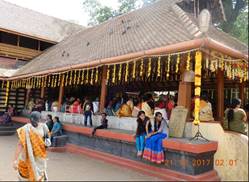
The Bhagavatghi Temple in Alappuzha.
No visit to this part of the country is complete if we do not include a boat trip on the backwaters along the Arabian coast of Southern Kerala. After a visit to the ancient Bhagavathy temple in Alappuzha, near Kochi, we went into the modern resort of Punnamada to savor the beautiful backwaters. Floating along the rivers in a small open boat with several houseboats going past us, it was idyllic. We floated past neighborhoods along very
narrow canals barely 20-feet wide and navigable only in motorized canoes. It was amazing how people have made a lifestyle along this maze of intricate waterways.
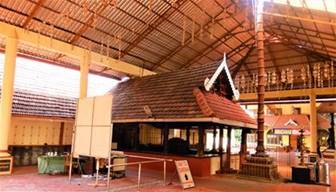
    Temple worshipped by Adi Shankara in Kaaladi.
Though the waters were clear and lapped gently along the sides, you could see the water hyacinth (an invasive species of water plant) choking the waterways and affecting the aquatic life beneath. One

          A house boat in Kerala Kaayals.
hopes they find a way to rid these pests from destroying the natural flora and fauna of the waterways.
People living in Kerala have learned to live with water. You could see cheena valas (Chinese nets in Malayalam) dotting the seashores in Kochi. (See below the picture of the nets used to catch fish.) Now they are used mainly as a tourist attraction. With abundant coastlines and

            Cheena Valaas in Kochi.
backwaters, seafood is a staple in the Kerala diet for many. People use the waterways to go to work (see the photograph below). These special ferries worked like bus routes along the waters.
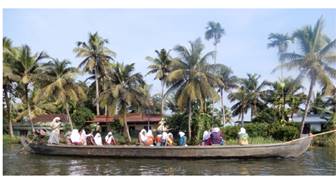
    A “commuter” boat in the Kerala backwaters.
It was a near perfect vacation, though very, very short. Soothing to the eyes and the spirit, a vacation trip to Southern Kerala is a must for any traveler in South India.   ♣
Home
Federal Indictments on Five Area Healthcare Providers in Opioid Case
Posted by admin in July 2018, Past issues on July 22, 2018
By Kollengode S Venkataraman
ThePatrika@aol.com
Federal prosecutors have indicted five area physicians for illegally prescribing Suboxone, a drug meant for treating opium addicts for mitigating withdrawal-related problems. Buprenorphine, marketed under trade names Suboxone and Subutex, among others, wards off the painful symptoms of opioid withdrawal and lessens cravings. The five physicians worked as contract employees at Redirection Treatment Advocates, LLC, (RTA) a business engaged in rehab work for opium addicts.
The federal indictments allege, “… the defendants, working as contractors at various locations, created and distributed unlawful prescriptions for buprenorphine, known as Subutex and Suboxone, a drug that should be used to treat individuals with opium addiction. The defendants are also charged with conspiracy to unlawfully distribute buprenorphine.†The defendants are charged also for allegedly causing fraudulent claims to be submitted to Medicare or Medicaid for payments to cover the costs of the unlawfully prescribed buprenorphine.â€
Details of the federal indictments are here: www.justice.gov/opa/pr/five-pennsylvania-physicians-charged-unlawfully-distributing-buprenorphine-and-defrauding. The healthcare providers indicted in federal courts in Pittsburgh and West Virginia are Krishan Aggarwal, 73, and Madhu Aggarwal, 69, both from Moon Twp; Cherian John, 65, of Coraopolis; Parth Barill, 69, of Pittsburgh; and Michael Bummer, 38, of Sewickley. An indictment is only an accusation. A defendant is presumed innocent unless and until proven guilty in a court of law.
Krishan Aggarwal, Madhu Aggarwal (OB-GYN) and Parth Barill, a gastroenterologist, earned their medical degrees from Rajasthan, India. Cherian John, earned his medical degree from Mumbai.
In a statement released, the US Attorney General Jeff Sessions said, “Today we are facing the worst drug crisis in American history, with one American dying of a drug overdose every nine minutes.â€
While announcing the indictment, US Attorney for Western Pennsylvania Scott Brady said, “Expanding the legitimate use of medication to treat addiction is a critical part of this administration’s multi-faceted approach to combat the opioid epidemic ravaging our communities. Yet another vital component is the prosecution of unscrupulous practitioners who abuse their privilege to practice medicine and dispense prescriptions unlawfully. These indictments demonstrate that we remain vigilant in our pursuit of physicians who ignore their oath to do no harm.â€Â   ♣
Home
Samar Saha: An Enthusiastic Organizer of Hindustani Music, Host & Patron for Musicians
Posted by admin in July 2018, Past issues on July 22, 2018
By Shailesh Surti, O’Hara Township, PA
Shailesh.surti@gmail.com
Editor: Music lovers here know Samar and Mala Saha of Irwin as great enthusiasts of classical Hindustani music, having enjoyed many 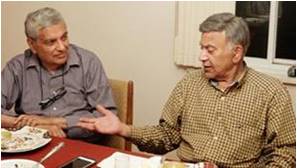 house concerts at the Sahas’ home in Irwin. In this engaging story, Shailesh Surti (left in the adjacent picture) draws out Samar Saha (right in the picture) on his exhilarating journey from his casual interest in Hindustani music to serious, passionate listener, organizer, host, and finally to patron of the music, and more importantly, of the musicians. The venue for this exchange was Shailesh’s home in O’Hara Twp, with his wife Urvashi as the gracious host. Â
house concerts at the Sahas’ home in Irwin. In this engaging story, Shailesh Surti (left in the adjacent picture) draws out Samar Saha (right in the picture) on his exhilarating journey from his casual interest in Hindustani music to serious, passionate listener, organizer, host, and finally to patron of the music, and more importantly, of the musicians. The venue for this exchange was Shailesh’s home in O’Hara Twp, with his wife Urvashi as the gracious host. Â
For any type of performing art — music and dance recitals, drama and live stage performances — to flourish anywhere, one needs art lovers, organizers, and patrons willing to underwrite a good part of the expenses above and beyond gate collections.
It is a well-recognized truism that “classical†art forms simply cannot sustain themselves merely on the basis of ticket-buying audience
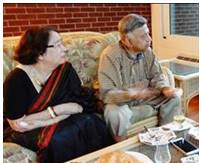
Mala and Samar Saha at the Surti residence.
support. This is the reality today both in Indian and Western performing arts. In the US, corporations and individual donors make huge contributions to symphonies and operas. In Europe, public funding for the performing arts has been the norm. In India, without corporate and government sponsors, the performing arts simply cannot survive.
 The Indian performing arts scene here: Pittsburgh has only around 20,000 Indian-Americans, with
fewer classical music enthusiasts compared even to Cleveland, which is demographically comparable to Pittsburgh on many measures. Here, Sri Venkateswara Temple has been organizing and patronizing classical Indian music concerts — especially Karnatic music — on a regular basis. Other temples also have done so in the past. Students of the Pandit Jasraj Institute of Music have organized concerts of artistes belonging to their gharana.
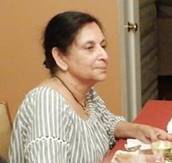
Urvashi Surti, the gracious host of the evening.
Fortunately, a few individuals, on their own drive and initiative, have been active in organizing Hindustani music concerts in Pittsburgh for a long time. For over 30 years, Dr. Balwant Dixit, under the banner of the Center for the Performing Arts of India at the University of Pittsburgh, organized many such events, both in Pittsburgh and around North America with concert tours for Indian artistes. In the early days, Dixit also organized Karnatic music programs in our town.
With Dixit now in retirement, Samar Saha and his wife Mala of Irwin have taken on the mantle for organizing Hindustani music concerts. Music lovers in our area owe the Sahas a big Thank You not only for their enthusiastic support for the art form, but also, more importantly, for their multi-faceted patronage for the artistes. The Sahas moved into the Pittsburgh area fifteen years ago after Samar retired from a job in New Jersey. Samar, a metallurgist by profession, joined US Steel’s R&D after arriving from New Jersey.
Samar had his early schooling in Banaras where he got interested in learning the tabla. But his father would not encourage him to go
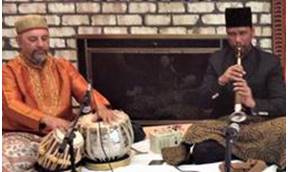
Ustad Haidar Hassan on the shehnai accompanied by Pt. Samir Chatterjee (tabla).
into music. Samar used a colorful expression to describe how his father reacted when he told his dad he wanted to pursue music.
Later, his interest in classical music blossomed when he went to college in Kolkata. During his tumultuous college days in the 1960s, with the Naxalbari Movement in full swing in Bengal, Samar managed to attend all-night concerts of artistes of great repute. His interest in cultivating a keen interest in music and musicians was greatly reinforced.
Samar even dabbled in western music in college. In 1975, he married Mala — it was an arranged marriage. Mala had her training in Rabindra Sangeet and Hindustani classical music. So it was natural both the Sahas are passionate about music.
The Sahas’ move to the US in the early 1970s directly as green-card holders was quite accidental. They settled down in New Jersey. While in New Jersey Samar became part of the Bengali Cultural Organization Kallol.
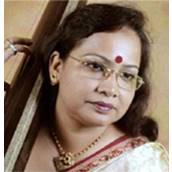
   Rajyashree Ghosh
At Kallol he introduced Hindustani cassical music concerts despite the apprehension of some members that it might not go well with their members. With the concerts well-liked by the members, Samar got first-hand experience in organizing music recitals and dealing with artistes.
The Sahas also came in contact with the tabla maestro Pandit Samir Chatterjee and his organization Chhandayan of New York. Chhandayan has been active with Indian musicians of every genus, innovating and experimenting with fusion, and tabla orchestra with vocalists. Chhandayan selects and invites artistes to perform around the USA.
With their long-standing association with Samir Chatterjee, Samar and Mala snap up opportunities to invite artistes and host them at their home. Asish and Nidrita Sinha of Cheswick are always there playing key roles in the organizing details.
Hosting artistes is not a simple job. By nature, artistes can be temperamental and picky. Receiving them at the airport, driving them around and dropping them back is a chore. But catering to their minute needs in food preferences and other needs is a different type of challenge. Samar and Mala have mastered the art of dealing with artistes.
Sometimes for a well-known artist the venue is moved to a formal auditorium, like the last concert this May of vocalist Ashwini Bhide Deshpande at the Frick’s Fine Arts’ Auditorium in Oakland. Many instrumentalists and vocalists, enjoying the Sahas’ hospitality at their home, have given their best recitals. Last year we enjoyed the Sarod player Sri Atish Mukhopadhyay accompanied on the tabla by Sri Tejas Tope. The other notable program was the nearly 3 hour memorable solo shahnai recital by Ustad Hasan Haide. Pt. Samir Chatterjee accompanied him on the tabla. Reviews of several of these recitals have appeared in the Patrika written by    knowledgeable music enthusiasts living among us.
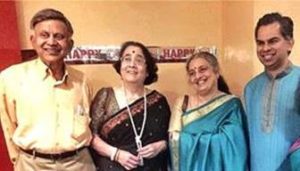
L to R: The Sahas, Ashwini Bhide and her Harmonium accompanist Kedar Naphade.
The Sahas have a lovely home in Irwin with a great room that can accommodate a small audience of up to fifty music enthusiasts to enjoy live performances. Samar has equipped his beautifully decorated home with a good sound system. Listening to the music is not the only treat at his place. The ambiance of a private house concert offers wonderful opportunities to interact with the artistes. The artistes too have said during the post-recital interactions that the sterile and formal atmosphere in large concert halls is no match for the instantaneous rapport they make with their audience sitting only feet away from them in house concerts. The concert is always followed by a scrumptious dinner, usually organized in potluck fashion with many in the audience bringing home-cooked delicacies.
The Sahas take great pride in hosting talented, young artistes, who give their very best in trying to establish themselves in the field. Many of them will never forget the Sahas’ patronage. The Sahas also encourage our own home-grown talents like vocalist young Ayan Sinha. Here are some of the artistes who have performed at the Sahas’ place:
- Padma Bhushan Pt. Buddhadeb Dasgupta (Sarod) opened the house concert with his blessings for success. His son, Anirban Dasgupta, another Sarod player played with him. August, 2012.
- Flutist Steve Gorn — April, 2013
- Classical Vocalist Mitali Bhowmik — May, 2014
- Thumri, Dadra and Ghazals by Rita Ganguly and Sitarist Amie Maciszewski — October, 2014
- Classical Vocalist Samarth Nagarkar — May 2015
- Thumri, Dadra and Durga Vandana Singer Rajyasree Ghosh — October, 2015
- Sitarist Abhik Mukherji and Flutist Jay Gandhi Jugalbandi — April 2016 (during the wedding reception of the Sahas’ daughter, Elena)
- Classical Vocalist Sanjoy Banerjee — April, 2017
- Shehnai Haidar Hassan – son of Shehnai Nawaz Late Ut. Ali Ahmed Hussain Khan -— May 2017
- Sarodist Atish Mukhopadhyay — October 2017
- Classical Vocalist Ashwini Bhide — May 20, 2018
Without letting anybody know (until now), very often, the Sahas, like true patrons of arts, have contributed from their own resources, a lion’s share of the total expenses for many of these concerts. This is in addition to hosting the artistes in their home for several days before and after the recital.
That they are Hindustani music enthusiasts is well-known. Further, without any institutional support here, and on their own strength, they are also warm hosts, efficient organizers, and generous patrons of the art and the artistes, all rolled into one. The Sahas are unique in this respect.  ♣
Home
Consul General of India Visits the Asian Studies Center at Pitt
Posted by admin in July 2018, Past issues on July 22, 2018
The Asian Studies Center at the University of Pittsburgh was delighted to host the Consul General of India, Mr. Sandeep Chakravorty, on March 28th and 29th 2018. The Consul General was invited to by the University of Pittsburgh for a major conference “Rethinking South-South Cooperation: India and Brazil in the 21st Century,†organized under the auspices of the University Center for International Studies.
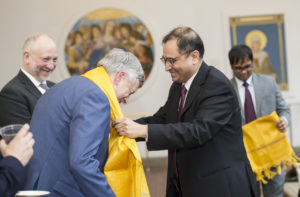
Consul General Sandeep Chakravorty facilitates Pitt’s Chancellor Emeritus Mark Nordenberg with a traditional Indian scarf. Extreme left is Vice Provost of Global Affairs Ariel Armony,
In conjunction with this, the Consul General of India participated in a series of events focused on the development of Indian Studies, toured the Indian Nationality Room in the Cathedral of Learning and met with a group of students representing a tremendous cross-section of interests in Indian Studies in particular and South Asia more broadly. Mr. Chakravorty and his staff have been extremely helpful in working with senior leadership at the University of Pittsburgh, and with Ms. Riva Ganguly Das, Director General of the Indian Council for Cultural Relations, to establish the ICCR Chair in Indian Studies.
Over the course of the next five years, this important initiative will bring leading scholars from universities in India to the University of Pittsburgh to teach courses that focus on Indian society and culture in the humanities and social sciences.
The ICCR Chair in Indian Studies will serve to anchor and help to develop an important initiative. Recognizing the growth and development of South Asia, the Asian Studies Center at the University of Pittsburgh is committed to expanding faculty research and teaching expertise on the global significance of this significant region of the world.
Beyond the academic significance of the “India Initiative†at the University of Pittsburgh, the establishment of the ICCR Indian Studies Chair will serve as an important bridge to the community.
In conjunction with this goal, Consul General Chakravorty was able to meet representatives of Pittsburgh’s community who have contributed to Indian studies over the years, most especially those who have played a vital role in building and supporting the Indian Nationality Room  ♣
Home
The Wadhwani Institute of Artificial Intelligence Inaugurated in Mumbai
Posted by admin in July 2018, Past issues on July 22, 2018
By K S Venkataraman
ThePatrika@aol.com
Sunil Wadhwani and his wife Nita are well known in our region’s city and county governments and civic institutions. He was the founding CEO of i-Gate, a global software company, known in its previous incarnation as Mastech, a company he co-founded with Ashok Trivedi. At the peak of his career as the CEO of i-Gate, over 30,000 employees were on its payroll in 70-plus offices worldwide with over $1 billion in annual revenue.
In the middle of this, Sunil took great interest in promoting Pittsburgh, a second-tier US City, as the destination of choice for national and international businesses to relocate or open their offices. At the same time, Wadhwani also worked with city and county elected officials to diversify the region’s population making it attractive for immigrants, a feature that global businesses consider desirable in their decision to relocate or open a new office in a new place. After all, our region has all the accoutrements needed — affordable housing, good public and private schools, excellent medical facilities, universities, sports teams, museums, and other entertainments…
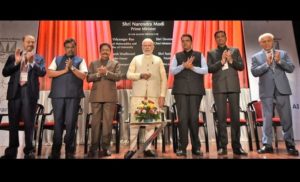
Sunil Wadhwani is extreme left and his elder brother Romesh Wadhwani is extreme right. Maharashtra’s Governor Mr. C Vidyasagar Rao is third from left and Chief Minister Mr Devendra Fadnavis is third from right, on the stage during the inaugural function. Prime Minister Modi is in the middle.
In 2015, Capgemini, a French IT services company, acquired i-Gate for over $4 billion. Now, Wadhwani is in semi-retirement, yet active in running SWAT, a venture capital company based in Moon, as a managing partner, along with Ashok Trivedi.
“Most of us who grew up in India and moved to the US have been extremely fortunate. We had parents who cared for us and had the means to educate us in good schools and send us to the US. Many billions of people around the world — especially those struggling in poverty in India and other developing countries — are not so lucky. It is up to us to help our fellow human beings who have not been as blessed.†Sunil’s thoughts have been drifting along these lines for quite some time.
So he decided to put a small portion of his resources to good use in India, with possibilities of having a global impact. Joining with his older brother Romesh Wadhwani, a California-based venture capitalist, the two Wadhwanis each donated $15 million and founded the Wadhwani Institute for Artificial Intelligence (WIAI). The thrust of the Wadhwani Institute is “harnessing the power of AI to solve deep-rooted problems in healthcare, education, agriculture, and infrastructure to accelerate social development.†Though the institute’s beneficiaries can be global, its immediate focus is on the Indian subcontinent and Asia, where it is most needed, and where the impact can be high.
In March of this year, in Mumbai, the Wadhwani Institute of AI went on-stream, with India’s Prime Minister Narendra Modi inaugurating it in the presence of the Maharashtra Chief Minister Devendra Fadnavis, its Governor Vidyasagar and many other dignitaries. In the opening ceremony, Modi said, “The Wadhwani AI institute is a prime example of how the public sector and the private sector can come together with good intentions to build a world-class institute, aimed at benefiting the poor.”
Sunil said, “The government of Maharashtra has committed land, but the details are still being worked out. Currently, ten full-time employees are working at the institute, which is likely to go to 30-plus full-time employees specializing in AI in three years.†Around one hundred researchers from affiliated institutes outside India will be working on AI applications for social good at the institute.
The Wadhwani Institute, a fully independent body, will be closely working with the University of Bombay to develop a master’s program on Data Sciences and AI.
In a press release on the occasion, Sunil said, “AI is a game-changing technology. There’s a lot of research being done at companies like Amazon, Google and Alibaba, and at universities like Carnegie Mellon and MIT. However, virtually all of that is targeted at commercial applications, and there’s little or no research on how to use AI to accelerate social development. Our goal is to have, within the next two years, over 100 researchers working on leveraging AI to improve the quality of life for the bottom two billion people in the world.† So founding this institute is gratifying to the Wadhwani brothers and their families.
Responding to a question, Sunil said, “The institute is looking for hiring the best AI researchers from around the world who are also passionate about social development. Because of our location in India and our initial focus on applying AI to social development in India and other developing countries, most of these have been of Indian origin so far. As we expand, we expect our workforce to become more global in nature.â€
Continuing, he said, “We are forming partnerships with the world’s leading AI research institutions to work together on applying AI to accelerate social development. We have already formed such partnerships with MIT, Carnegie-Mellon University, New York University, the University of Washington, and the University of Southern California.
As part of the launch of the institute in March in Mumbai, Wadhwani Institute hosted a summit of seventy-five leading AI researchers, social sector experts and senior government officials to identify challenges that could be addressed using AI. Ideas discussed included using AI to help farmers on when they should plant their seeds for best crop yields, improving the effectiveness of community health workers, addressing high dropout rates in rural schools, making educational content available in local languages and dialects, and facilitating the early detection of diseases.
Indeed, ambitious objectives for social good on many fronts. ♣
Home
Our Region’s First Nonstop Flight to Asia
Posted by admin in July 2018, Past issues on July 22, 2018
By Kollengode S Venkataraman
ThePatrika@aol.com
After considerable effort, the Allegheny County Airport Authority finally succeeded in cracking into the Asian aviation market with a chartered nonstop flight to Shanghai, operated by China Eastern Airlines, starting this August. One hopes that the charter nonstop flights to Shanghai is just the beginning for Pittsburgh International to get nonstops to other Asian destinations. It must grow into a seasonal and then regular three or four weekly flights all year around.
This nonstop came with a price tag for the region: The airport authority is pitching in up to $560,000 to subsidize the flight. This is essentially tax-payer money. That amount will drop  when Pittsburgh travelers purchase tickets, according to the Authority’s spokesman Bob Kerlik.
 In addition, the VisitPittsburgh tourism agency is kicking in another $300,000, with another $50,000 coming from the Idea Foundry, a Pittsburgh-based nonprofit that works with Chinese families and students to encourage educational ties and investment.
In addition, the VisitPittsburgh tourism agency is kicking in another $300,000, with another $50,000 coming from the Idea Foundry, a Pittsburgh-based nonprofit that works with Chinese families and students to encourage educational ties and investment.
The subsidies are part of a three-year agreement with Caissa Touristic, the tour operator, to market and sell trips to Pittsburgh. However, the flight currently is guaranteed for only one year.
Remember, in the heyday of US Airways at Pittsburgh International we had daily nonstop and direct service from PIT to Paris, Frankfurt, London, Rome, London, Milan… … And then the sky fell for us when US Airways walked away from its hub here, only to eventually disappear altogether from the skies. Recently Pittsburgh International inaugurated nonstops to Europe through WOW and Condor airlines.
The Patrika has written on the need for connecting PIT to Asia with nonstops for our region to encourage businesses to relocate here. However, anybody who is even peripherally familiar with the commercial aviation industry knows that the center of gravity of commercial airlines has shifted to Asia (Singapore, Thailand, Malaysia, China, and India). The commercial airline industry will grow for the next several decades in this region domestically, regionally, and even globally. Europe and North America are saturated markets.
The Big-Three US air carriers — United, Delta, and American — dominate global nonstops through their hubs across the US. Working to get American or other large European air carriers to introduce nonstops from Pittsburgh International to Europe and Asia is just a waste of time. That is why airlines from China, India, South East Asia, and the Persian Gulf countries has become attractive for Pittsburgh International to get nonstops to Asian destinations.
China Eastern Airlines nonstop seasonal charter service connecting Pittsburgh and Shanghai, China commences on August 3. This is the region’s very first nonstop air link with China, or for that matter, the the whole of Asia. Pittsburgh will be the arriving and departing gateway for hundreds of Chinese tourists visiting the U.S. East Coast this summer.
“This is a fantastic opportunity for our region to become the first medium-size city in the country as a destination for Chinese tourists,†Allegheny County Executive Rich Fitzgerald said. “Our region’s businesses, the airport, and our tourism industry will be the primary beneficiary of this agreement.â€
China Eastern will fly its flagship Boeing 777-300 ER, carrying 316 seats in a first/business/economy three-class configuration. The first departure from Pittsburgh will occur the same day as its landing.
“This is huge step forward for the future, particularly for nonstop air service to China. The charter-to-scheduled service model has been successfully adopted in other parts of the world,†said Christina Cassotis, Pittsburgh International Airport CEO. “We are the first U.S. market to tap into China’s fast-growing tourism market with this type of business model.â€
Pittsburgh area travelers will be able to purchase tickets on these flights through www.Travel2.com and www.firstinservice.com. Flights start at just $1,098 inclusive of tax and fees. Travel2 has also put together land packages starting as low as $990 when booked in conjunction with these flights. For all bookings, inquiries, terms, and conditions contact michelle@fls.com or call 310-435-3977.  ♣
Home
Trump’s Bravado Is Counterproductive
Posted by admin in July 2018, Past issues on July 22, 2018
By Kollengode S Venkataraman
ThePatrika@aol.com
As a New York real estate tycoon and casino owner in Nevada, Donald Trump’s management style was to keep his subordinates, competition, vendors, clients guessing, and spring surprises in meetings to have an upper hand. But it did not always work for him. His businesses filed for Chapter-11 bankruptcies six times. Trump’s ad hoc working style and blowing hot and cold unabatedly followed him to the Oval Office on appointments, domestic and trade policies, and foreign affairs. This style is bad for running the behemoth called the Government of the United States, whose tentacles in military alliances, intelligence operations, business/trading interests, are spread all over the world.
So, managing US relations with allies and trading partners, and dealing with threats and enemies require a steady hand at the helm to diplomatically coordinate the policies. Thousands of dedicated government officials work for him doing the groundwork for months, even years, to build consensus on complex, sensitive issues, so that in summits, leaders can sign agreements on issues on substance under good optics.

The other G-7 leaders confronting Donald Trump at the G-7 meeting in Canada in May 2018.
Trump’s adhocism on policies makes it difficult, to put it generously, for officials to negotiate on his behalf. He erratically turns the rudder wheel of the huge ship of the State with bluster, as he did in the G-7 meeting in Canada in June. The confrontational picture describes the acrimony in the meeting.
President Trump may think — even believe — that the brashly displaying American raw power in summits will make US allies genuflect before him and scare hostile nations into submission. The “Sole Super Power†sobriquet for the US will be honored by allies — and feared by enemies — only if the US uses its power with discretion and finesse. His bluster and bravado weaken the alliance, only making Russia and China happy.
Even in domestic politics, one wonders if Trump is helping or hurting the GOP by his brazenness. — By KSV
Home
Links to the e-Books of the Past Issues
Posted by admin in Soft Copies of Past issues on April 8, 2018
Click any link below to go to the specific issue:
April 2023 Issue of the Patrika
January 2023 Issue of the Patrika
October 2022 Issue of the Patrika
July 2022 Issue of the Patrika
April 2022 Issue of the Patrika
January 2022 Issue of the Patrika
October 2021 Issue of the Patrika
July 2021 Issue of the Patrika
April 2021 Issue of the Patrika
January 2021 Issue of the Patrika
April, July & Oct 2020 Issues of the Patrika
January 2020 Issue of the Patrika
October 2019 Issue of the Patrika
July 2019 Issue of the Patrika
April 2019 Issue of the PatrikaÂ
January 2019 Issue of the Patrika
October 2018 Issue of the Patrika
July 2018 Issue of the Patrika
April 2018 Issue of the Patrika
January 2018 issue of the Patrika
October 2017 Issue of the Patrika
April 2017 Issue of the Patrika
January_2017_Issue of the Patrika
October 2016 Issue of the Patrika
July 2016 Issue of the Patrika
April 2016 Issue of the Patrika
January 2016 issue of the Patrika
October 2015 issue of the Patrika
July 2015 issue of the Patrika
April 2015 issue of the Patrika
January_2015_Issue Of the Patrika
October_2014_Issue Of the Patrika
July_2014_Issue Of the Patrika
April_2014_Issue of the Patrika
January_2014_Issue of the Patrika
October_2013_Issue of the Patrika
July 2013_Issue of the Patrika
Home
India’s One Quintessential Salesman
Posted by admin in April 2018, Past issues on April 4, 2018
By Kollengode S Venkataraman
Last December [2017], I was in Coimbatore, in Tamil Nadu, a self-made city built by the enterprising instincts of Kongu Vellalars (Gounders) and Naidus, the two major communities that pretty much built the city and the region surrounding the city from scratch, with practically no support from federal or state governments or investments in public sector companies. The medical care facilities in primary, secondary and tertiary healthcare in Coimbatore is as good as it is in Chennai, only less expensive.
[One important observation in diversion: Private sector doctors do not care – and perhaps do not even want primary and preventive health care. After all, with poor emphasis and priority on primary care with its emphasis on preventive medicine, in due course of time, everybody ends up in secondary and tertiary health care facilities, costing several multiple times compared to what preventive care costs. By far one of the most predatory health care systems in the world is in India.) That is where all the money is to be made for the healthcare industry in India — doctors, testing labs, pharma companies, and a horde of healthcare support services. The tertiary healthcare facility is the ultimate akshaya patram for the doctors and hospitals. Many working class families without access to hard currency from their sons and daughters in the Persian Gulf, Malaysia, Singapore, and the Gora lands, are on the brink of financial ruins.  This is another topic for another day.]
Kongu Vellalar’s (Gounders’) and Naidus’ footprints are everywhere in Coimbatore and its surrounding area – in elementary, primary, secondary education in schools they have build in the names of their parents; 4-year colleges in arts and science; medical and engineering colleges; hospitals, primary care centers and charities in their parents’ names; small and medium businesses and industries; and in supporting temples and patronizing performing arts. In the arid Kongu region where one needs to go 300 to 400 feet deep to get water, these people of the region also engage in farming and agriculture. That is how hardworking and enterprising the people in the region are.
We were in the shopping area along Hundred-Feet Road in Coimbatore looking for a Pattu Paavaadai (reshmi lehnga) for my 3-yar old grand daughter. Hundred-Feet Road had several showrooms for silk saris and gold/diamond jewelry. These shops specializing in silks only sell the fabric in pure Kanchi and other specialty silks for Paavaadais for 2 to 12-year old girls. The Paavaadai fabric, like expensive saris, comes with matching material for the blouse integrally woven at one end of the fabric.
My wife and I were debating how the green pavadai would go with the pink/red blouse material for our 3-year old brown grand daughter. The salesman heard our discussion: “Ayya, oru nimisham,†or “Sir, wait an minute.†He continued in Tamil: “I will show you how it would look as a paavaadai-jaaket pair.â€
I don’t know what he did, or how he did it. Within 30 seconds, he folded the single piece of silk fabric in a few complicated steps. Bingo! Magically, he made the same piece of fabric look like a paavaadai-blouse pair.
“Ayya, ippa parunga.†Or, “Sir, now you see.†With a smile on his face, he continued in Tamil, “This is how it would look on your grand daughter.â€
I asked him to pose for a picture. And here it is.
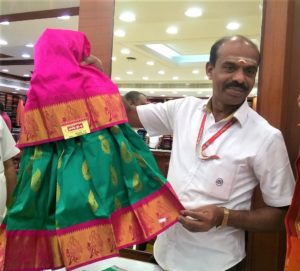
Needless to say, he was so good, I also ended up buying more material than what I had in mind when I entered the shop. ♣
Home
Young Men and Women in India Choosing Their Partners on Their Own Is Nothing New
Posted by admin in April 2018, Past issues on April 4, 2018
By K S Venkataraman
    Young Indian men and women in the US or in India increasingly choose their own partners now. Parents are usually informed that they are “seeing someone†who they met in college/at work/on online dating sites. In the due course of time, these youngsters eventually settle down in life with their choice of life partners.
Young men and women choosing life partners on their own is not entirely a new phenomenon in India. Literature dated 2500 years before our time has poems describing the lament of parents over their daughter leaving with her beloved without even informing them! Here is an example.
    Aga-Naanooru is an anthology of 400 verses in classical Tamil. Here is the verse in Aga-Naanooru in the original, by the poet Karuvoor Kannambalanaar. (Reference: Aga-Naanooru by Puliyoor Kesikan, Pari Nalayam, Chennai, Verse 263):
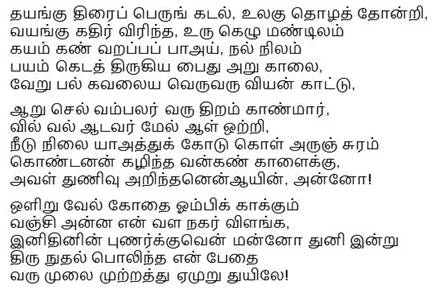
The verses in Aga-Naanooru are dated between 600 years BC and 300 years AD. (Incidentally, the UN has declared Tamil as a classical language of the world. The other UN-recognized classical languages are Sanskrit, Mandarin, Greek, Latin, and Hebrew. India is the birthplace of two of the world’s classical languages.)
    The language in these verses is old classical Tamil that most Tamils of today cannot understand without the help of commentary by scholars. The gist — not a translation — of the verse is this:
   The Sun making waves in the oceans is worshipped all over the world, But this summer, it has dried the lakes and ponds, making the rich farmlands fallow, thus plunging farmers into poverty.Â
    In this hot summer, along a trail through the forest used by people to go from one village to another, in an area with thick foliage, thieves with bows are hiding on higher branches of tall trees to rob travelers.Â
    My innocent daughter has left my house eloping with her lover, and now has to travel through the dangerous forest… …
    The neighboring City of Vanji is well protected by Kothai, its courageous spear-bearing king. Even my prosperous farmland is as safe as Vanji. If only I had known my daughter’s love for her beloved, willingly and without any ill feeling and rancor, I would have arranged the marriage of my virtuous, innocent daughter with a lovely, bright forehead such that her beloved can rest his head on the valley between her still-growing breasts and sleep. Alas! I cannot do this for her now.
    So, relax and take it easy if your wards go on their own in choosing their life partners. This has been the way of the world all over. Besides, there is nothing else you can do about it anyway!  ♣
Home
Weekend in the Only Ice Hotel in Quebec City
Posted by admin in April 2018, Past issues on April 4, 2018
By Rahul Dilip Tendulkar, Shaker Heights, Ohio
Editor’s Note: Rahul Dilip Tendulkar was born and raised in Grand Blanc, MI. He went to medical school 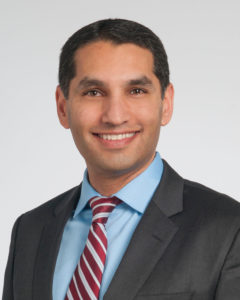 at the University of Michigan, and finished his residency in radiation oncology at the Cleveland Clinic, where he is at the Taussig Cancer Center. He married Rajani, daughter of Arvind and Deepa Koimattur of Monroeville. The Tendulkars and their two daughters live in the Cleveland Metro area. Rahul enjoys traveling, publishing papers and tennis.
at the University of Michigan, and finished his residency in radiation oncology at the Cleveland Clinic, where he is at the Taussig Cancer Center. He married Rajani, daughter of Arvind and Deepa Koimattur of Monroeville. The Tendulkars and their two daughters live in the Cleveland Metro area. Rahul enjoys traveling, publishing papers and tennis.
My wife Rajani, daughter of Deepa and Arvind Koimattur of Monroeville, was born on a cold and snowy January day in Pittsburgh in 1978. Naturally, she wanted to spend her milestone 40th birthday not on a warm beach, but rather in an environment similar to the day of her

Rahul and Rajani with their kids in the hotel lobby.
birth. So our family planned a special trip to visit the Hotel de Glace just outside of Quebec City, Canada, which is the only ice hotel in North America. Accompanied by her daughters Parisa and S
amira, myself, and her parents Deepa and Arwind Koimattur, we packed our bags with extreme cold weather gear to withstand the arctic blast that weathermen were predicting to sweep through the continent.
The Hotel de Glace, which is only open from January to March each year, is constructed by local artists who spend weeks putting together the massive structure out of snow and blocks of ice. Like a giant igloo, the indoor temperature remains surprisingly constant around 25 degrees F despite the subzero wind-chill temperatures outdoors.
The hotel is an architectural phenomenon, with a bar, a chapel, and forty-five

Aravind Koimattur enjoying the freezing cold with his wife Deepa and grand kid at the ice hotel.
distinctive guest rooms. The bar area was equipped with bright LED lights, dance music, a fireplace, and drinks served in glasses made of ice — it was quite the party! Intricately designed ice sculptures were there in every corner and even hanging from the arched ceilings.
Each bedroom was uniquely crafted, with beds made of ice and topped by a comfortable mattress with sleeping bags of the same kind as used by explorers
to the North Pole. We carefully tucked in the children first and zipped them up so only their eyes and noses were exposed. Getting ourselves into the sleeping bags proved to be even more tricky, but once we were able to zip ourselves in, our bodies (except for our faces) were remarkably comfortable. As parents, we didn’t sleep much that night, but our children slept like babies. We all woke up with a sense of accomplishment having survived a night outdoors in the coldest place we have ever visited! It was certainly an occasion to remember for the January birthday girl.  ♣
Home
A Memorable and Nostalgic Train Journey
Posted by admin in April 2018, Past issues on April 4, 2018
By Premlata Venkataraman   Â
e-mail: ThePatrika@aol.com
 Home, country, kinship can mean different things at various stages in your life. Confusing? Maybe not. For those of us who were born in one nation, but now call another our home, these concepts have been shifting. Ponder this: for many of us going to India on our first visit after being here for several years, it brings forth choking emotions of nostalgia, love for the place and people, self-doubt on our leaving India, even patriotism. However, after a few decades of living in the ‘Burgh, when returning from India, just a glimpse of the Three Perennial Rivers from the plane before landing gives us the relief and comfort of being home.
Home, country, kinship can mean different things at various stages in your life. Confusing? Maybe not. For those of us who were born in one nation, but now call another our home, these concepts have been shifting. Ponder this: for many of us going to India on our first visit after being here for several years, it brings forth choking emotions of nostalgia, love for the place and people, self-doubt on our leaving India, even patriotism. However, after a few decades of living in the ‘Burgh, when returning from India, just a glimpse of the Three Perennial Rivers from the plane before landing gives us the relief and comfort of being home.

Mangalore Junction.
With nostalgia, after thirty years, last December, I created an opportunity to travel through the lands where my parents were born and lived until adulthood — small-town Kerala they were from for generations before moving to Bombay, where they raised a family.
We settled on an 8-h long train journey along the West Coast of Southern India from Mangalore to Coimbatore. I had taken this route at least ten times from childhood through my young adulthood. People talk about the past flashing before their eyes. As the train was gently going past several small stations, memories of past images gushed past in my mind as I was looking through the window!
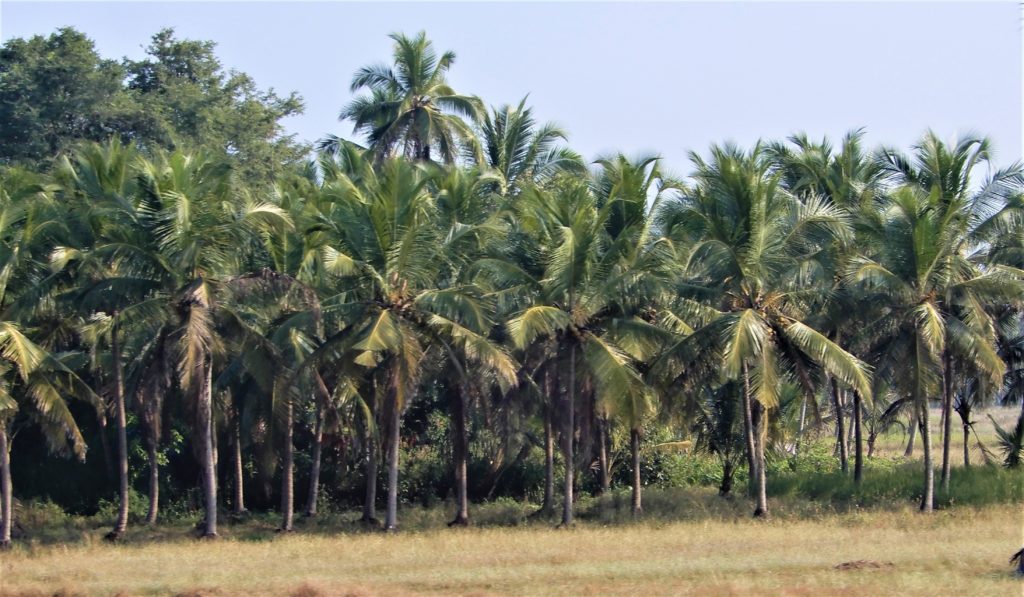
Coconut palms just 50 yards away from the railway track.
We boarded the train early in the morning at Mangalore Junction after going to the famous Mookambika and Udupi Temples. As the early sun was drenching the landscape with light, the train was gently going past a land of coconut groves densely dotting the green paddy fields. Acres and acres of green fields, stretched on a land watered by plenty of streams and rivers. Backwaters washed over the land, with bobbing fishing boats headed out to the Arabian Sea visible through the window.
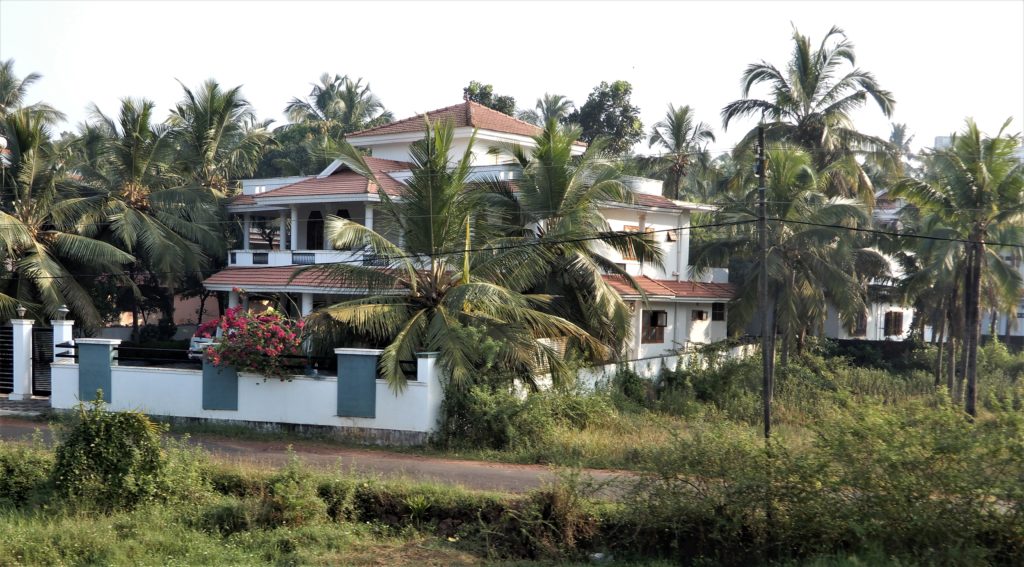
One of the countless homes along the track nestled around coconut palms.
The scene was so reminiscent of the many trips I had taken in my childhood traveling from Bombay to Kerala to visit grandparents and family. I distinctly remember now, as you enter Kerala from Coimbatore, the changing landscape from Tamil Nadu was so sudden and dramatic. That is why India has so many diverse languages and food preferences.

Palakkad Junction, nostalgically familiar to those from Kerala.
We passed through Kannur where my maternal grandfather taught mathematics and accounting at the European High School — the grandfather, I remember, wore a linen jacket and a cotton turban. We moved on to Thallassery, famous for black pepper, the home of my mother and her large family, onto Mahe, my father’s hometown. The train chugged on through Badagara where my parents lived for a short time before moving to Bombay. I re-lived the many stories told by my relatives at several family gatherings in my childhood.
About the Indian railways in South India: Having traveled in European and US trains, I must say, the Indian Railways system does an amazing job, when you consider that over 10 million people are on long-distance trains every day, and how relatively affordable the second-class tickets are to average Indians. A great improvement in the trains is new toilets that collect waste products, like in airplanes, leaving the railway tracks en route clean.
Ticket purchase is now as easy as on-line booking of airline tickets. The tickets give all the information of compartment number, (as the rail cars are called in India), its placement on the station platform and seat numbers. You are able to board the train with comfort and with no anxiety. The railway platforms in big stations are typically 1000 yards long. South Indian train stations are clean with enough seating for weary travelers. The longest trains, with 24 rail cars, are over 650 yards long.
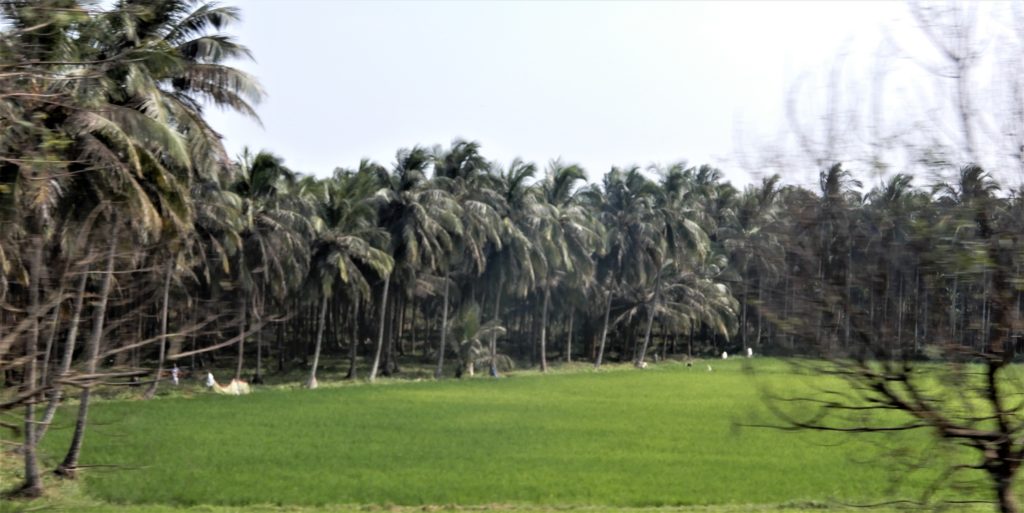
Verdant paddy fields in front of coconut palms — a common sight in central Kerala.
The railway staff was courteous and professional. A new development that pleased me was: all employees at stations waving the trains off were women in smart uniforms! Also, now women are in the driver’s seat, running the heavy electric locomotives in suburban trains as well.
The range and quality of food at the South Indian railway stations did not disappoint me. The food and newspaper stalls are all privatized, with lots of local delicacies. Snack packs of salty banana chips, cookies, halwas, crackers, and murukkus are available everywhere.
We had appam and stew for breakfast at the station. Our boxed lunch of rice, sambar and yoghurt too were served fresh. Nonvegetarian lunches too are available. One suggestion if you are travelling in long-distance trains: Take paper napkins, fork/spoons and bottled water before leaving home; and also some large trash bags to put all the waste you will generate.
The short 8-hour ride through a familiar, beautiful route made me nostalgic. So, if you have the time and the opportunity, travel in a long-distance train in India along a route familiar to you from your younger days. It is far more interesting than sterile air travel. It will bring back memories that you thought you’ve forgotten long, long ago.  ♣

